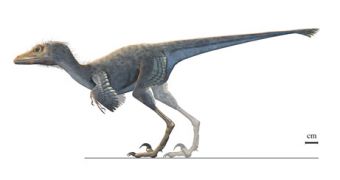Birds are considered dwarf flying dinosaurs. Now, an 80-million-year-old recently found dwarf dinosaur in the southern Gobi desert (Mongolia) could be a missing link in the evolutionary question of how the tiny birds evolved from the huge beasts.
The new feathered dinosaur, called Mahakala (after a Tibetan god) omnogovae, is only 27.5 inches (70 centimeters) long from its head to the tip of its tail. Many dinosaur discoveries in the last 10 years, from China to Spain, have revealed that some of them had their bodies covered in feathers, a clue of their potential connection to birds.
But only a few of the discovered feathered dinosaurs bore direct proof of the evolutionary changes developing the flight. Mahakala's small size enhances the concept that some theropods (bipedal carnivorous dinosaurs, like T-rex) dwarfed during the evolution to birds.
"Miniaturization has long been considered crucial to the origin of flight. Now Mahakala is providing the first signs of some of these early evolutionary steps." said lead researcher Alan Turner of New York's American Museum of Natural History.
Paleontologists encountered at the digging place Mahakala's fossilized skull, limbs and most of its spinal column.
"The fossils indicate that the new species was not only feathered but also likely had winglike forelimbs and hind limbs," Turner said.
"Many of the animals that were thought to look like giant lizards only a few years ago are now known to have been feathered and to have had many other defining bird characteristics," said co-author Mark Norell, curator at the natural history museum's division of paleontology.
Mahakala evolved from dromaeosaurids, a theropod family including the famous Velociraptor from the 1993 movie Jurassic Park.
"If Steven Spielberg were to make another Jurassic Park sequel, many of the dinosaurs that starred in the original film would require a complete makeover. The Velociraptor would be completely covered in feathers," said Turner.
"The discovery of Mahakala and other small birdlike dinosaurs is helping paleontologists paint new details on the mosaic depicting the first flight-capable birds' ascent from nonavian dinosaurs," said Xu Xing, one of China's leading dinosaur hunters and an expert on the evolution of feathered dinosaurs, not involved in this research.
Scientists are still puzzled how the ancient birds did not disappear together with the other dinosaurs 65 million years ago.
"Why some animals survive mass extinctions while others don't is one of the most difficult questions in paleontology. Flying doesn't seem to have hurt birds, yet pterosaurs-which are not dinosaurs-flew but went extinct." said Turner.
"A combination of birds' ability to fly and to evolve quickly might have helped them survive. Birds mature within one year, and that gives them the means to adapt very rapidly to big changes in the environment. They evolve much more quickly than massive dinosaurs or humans." said Xu.

 14 DAY TRIAL //
14 DAY TRIAL //